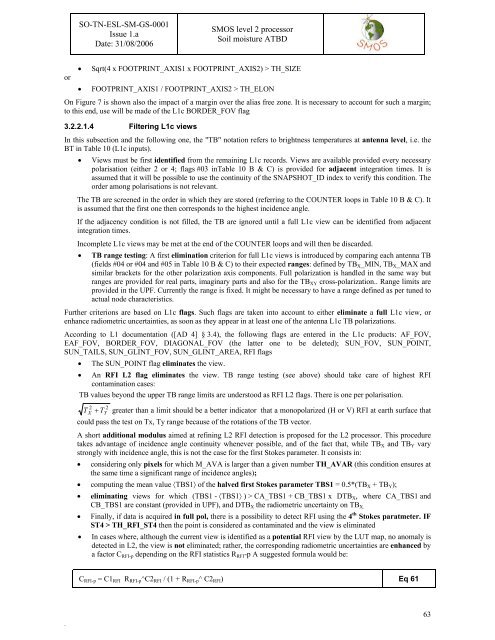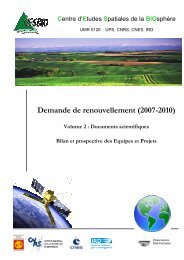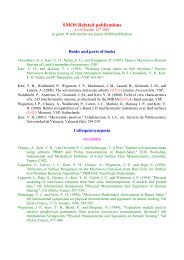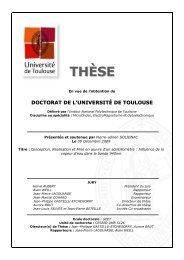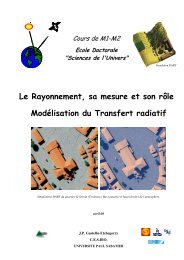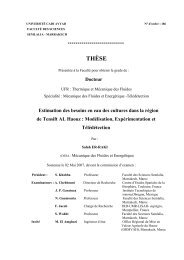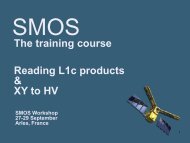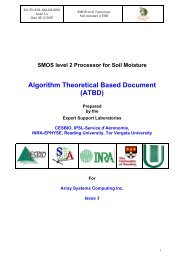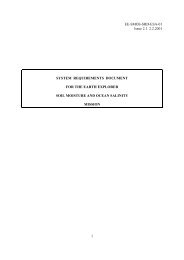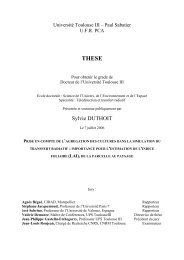Algorithm Theoretical Based Document (ATBD) - CESBIO
Algorithm Theoretical Based Document (ATBD) - CESBIO
Algorithm Theoretical Based Document (ATBD) - CESBIO
You also want an ePaper? Increase the reach of your titles
YUMPU automatically turns print PDFs into web optimized ePapers that Google loves.
SO-TN-ESL-SM-GS-0001<br />
Issue 1.a<br />
Date: 31/08/2006<br />
SMOS level 2 processor<br />
Soil moisture <strong>ATBD</strong><br />
• Sqrt(4 x FOOTPRINT_AXIS1 x FOOTPRINT_AXIS2) > TH_SIZE<br />
or<br />
• FOOTPRINT_AXIS1 / FOOTPRINT_AXIS2 > TH_ELON<br />
On Figure 7 is shown also the impact of a margin over the alias free zone. It is necessary to account for such a margin;<br />
to this end, use will be made of the L1c BORDER_FOV flag<br />
3.2.2.1.4 Filtering L1c views<br />
In this subsection and the following one, the "TB" notation refers to brightness temperatures at antenna level, i.e. the<br />
BT in Table 10 (L1c inputs).<br />
• Views must be first identified from the remaining L1c records. Views are available provided every necessary<br />
polarisation (either 2 or 4; flags #03 inTable 10 B & C) is provided for adjacent integration times. It is<br />
assumed that it will be possible to use the continuity of the SNAPSHOT_ID index to verify this condition. The<br />
order among polarisations is not relevant.<br />
The TB are screened in the order in which they are stored (referring to the COUNTER loops in Table 10 B & C). It<br />
is assumed that the first one then corresponds to the highest incidence angle.<br />
If the adjacency condition is not filled, the TB are ignored until a full L1c view can be identified from adjacent<br />
integration times.<br />
Incomplete L1c views may be met at the end of the COUNTER loops and will then be discarded.<br />
• TB range testing: A first elimination criterion for full L1c views is introduced by comparing each antenna TB<br />
(fields #04 or #04 and #05 in Table 10 B & C) to their expected ranges: defined by TB X _MIN, TB X _MAX and<br />
similar brackets for the other polarization axis components. Full polarization is handled in the same way but<br />
ranges are provided for real parts, imaginary parts and also for the TB XY cross-polarization.. Range limits are<br />
provided in the UPF. Currently the range is fixed. It might be necessary to have a range defined as per tuned to<br />
actual node characteristics.<br />
Further criterions are based on L1c flags. Such flags are taken into account to either eliminate a full L1c view, or<br />
enhance radiometric uncertainties, as soon as they appear in at least one of the antenna L1c TB polarizations.<br />
According to L1 documentation ([AD 4] § 3.4), the following flags are entered in the L1c products: AF_FOV,<br />
EAF_FOV, BORDER_FOV, DIAGONAL_FOV (the latter one to be deleted); SUN_FOV, SUN_POINT,<br />
SUN_TAILS, SUN_GLINT_FOV, SUN_GLINT_AREA, RFI flags<br />
• The SUN_POINT flag eliminates the view.<br />
• An RFI L2 flag eliminates the view. TB range testing (see above) should take care of highest RFI<br />
contamination cases:<br />
TB values beyond the upper TB range limits are understood as RFI L2 flags. There is one per polarisation.<br />
2 2<br />
X T Y<br />
T + greater than a limit should be a better indicator that a monopolarized (H or V) RFI at earth surface that<br />
could pass the test on Tx, Ty range because of the rotations of the TB vector.<br />
A short additional modulus aimed at refining L2 RFI detection is proposed for the L2 processor. This procedure<br />
takes advantage of incidence angle continuity whenever possible, and of the fact that, while TB X and TB Y vary<br />
strongly with incidence angle, this is not the case for the first Stokes parameter. It consists in:<br />
• considering only pixels for which M_AVA is larger than a given number TH_AVAR (this condition ensures at<br />
the same time a significant range of incidence angles);<br />
• computing the mean value 〈TBS1〉 of the halved first Stokes parameter TBS1 = 0.5*(TB X + TB Y );<br />
• eliminating views for which (TBS1 - 〈TBS1〉 ) > CA_TBS1 + CB_TBS1 x DTB X , where CA_TBS1 and<br />
CB_TBS1 are constant (provided in UPF), and DTB X the radiometric uncertainty on TB X.<br />
• Finally, if data is acquired in full pol, there is a possibility to detect RFI using the 4 th Stokes paratmeter. IF<br />
ST4 > TH_RFI_ST4 then the point is considered as contaminated and the view is eliminated<br />
• In cases where, although the current view is identified as a potential RFI view by the LUT map, no anomaly is<br />
detected in L2, the view is not eliminated; rather, the corresponding radiometric uncertainties are enhanced by<br />
a factor C RFI-p depending on the RFI statistics R RFI -p A suggested formula would be:<br />
C RFI-p = C1 RFI R RFI-p^C2 RFI / (1 + R RFI-p^ C2 RFI ) Eq 61<br />
.<br />
63


